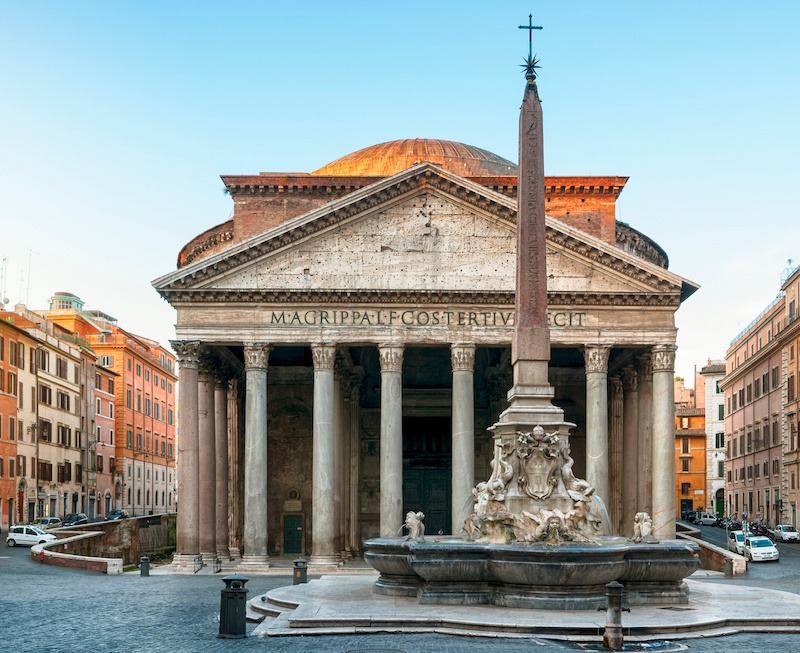The magnificence and the extremely high architectural genius of the ancient Romans are still testified today by a symbolic monument of the Eternal City: we are talking about the Pantheon, an iconic monument that stands imposingly in the heart of Rome, and today we will reveal 6 things you may not know about the Pantheon, making it undoubtedly an unmissable destination during your stay in the Eternal City.
If you are in Rome and are looking for a monument that combines history, art, culture, and Roman ingenuity in one place, you cannot miss the Pantheon. Arriving at its sight will be a surprise that will literally take your breath away: the narrow alleys leading to Piazza della Rotonda – this is the name of the square hosting the monument – will suddenly give way to a spacious area characterized by typical restaurants and bars, with the Pantheon and its perfect spherical shape towering as the protagonist of the scene.
First, let’s talk about some important records: the Pantheon is one of the very few Roman constructions still perfectly intact, which gives us an insight into the greatness of the Roman people in terms of constructions. Furthermore, its dome is the second largest in the world, surpassed only by the Dome of the Florence Cathedral by Brunelleschi. If you are not satisfied with this information, continue reading because we will reveal some curiosities about one of the symbols of the Eternal City.
1. Why it was built there?
Why was the Pantheon erected precisely in that location, completely decentralized from the Imperial Forums and the Colosseum? Some historians argue that the current Piazza della Rotonda was the place from which Romulus “ascended” into heaven during a ceremony, which was interrupted by a violent rainstorm. To commemorate this event, the Romans decided to build a small shrine here.
2. The First Pantheon
The construction of the Pantheon that has come down to us intact was done during the time of Hadrian, precisely in 126 AD, but it is called “Pantheon of Agrippa” because it was built where previously, in 27 BC, there was a first Pantheon, different from the one that reached us, commissioned by Augustus’s son-in-law in honor of the 7 planetary deities, which was then destroyed by fire in 80 AD.
3. “What the barbarians didn’t do, Barberini did.”
We mentioned earlier Hadrian, the emperor who wanted to radically rebuild the Pantheon and to whom undoubtedly we owe the introduction of the portico and its gigantic 16 columns. To honor his illustrious predecessor, he had a bronze plaque made which read: “Marcus Agrippa, son of Lucius, Consul for the third time, built [this], of which we now only have a reconstruction.” This plaque had a very short life because Pope Urban VIII Barberini plundered that material to allow the creation of Bernini’s Baldacchino inside St. Peter’s Basilica. After this sad event, a popular Roman saying spread, which went like this: “What the barbarians didn’t do, Barberini did.”
4. It’s Always about the papacy…
From a pagan construction, the Pantheon in 608 became a place of Christian worship by the work of Pope Boniface IV, who moved inside it the remains of some martyrs found in the Christian catacombs.
5. A False Myth
Probably the most well-known fact about the Pantheon is the presence of this “eye” with a diameter of 9 meters at the center of the gigantic dome, which lets you glimpse the sky above the building. There are many legends associated with this sort of window, as well as many false myths: the most common is that despite this large opening, it does not rain inside the Pantheon. This is not true at all: it does rain inside the monument, but the floor has been designed to direct the water outside, with drains that channel away rainwater.
6. A Royal Cemetery
Not everyone knows that inside the Pantheon are kept the bodies of the first kings of Italy from the House of Savoy, Vittorio Emanuele II, Umberto I, and Margherita di Savoia. Moreover, even the great Raphael is buried here by his own will.
Conclusion
Now that we have revealed some curiosities about this incredible monument, you cannot fail to dedicate part of your day to visiting this incredible building steeped in history and legends.
The Basilica is open every day from 9 am to 7 pm. From July 2023, to access its interior, it is necessary to have an entrance ticket.
Consult our pages to request a private tour to discover Rome that also includes the Pantheon among the various stops.


